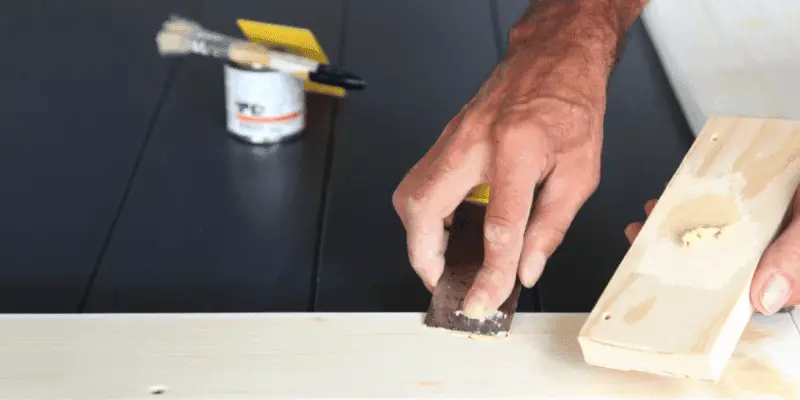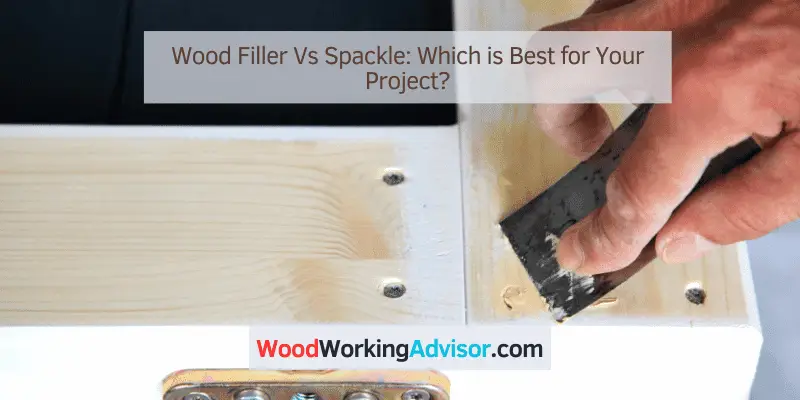Wood filler is used to fill and repair wood imperfections, while spackle is used to fill and repair imperfections on drywall and plaster surfaces. Wood filler and spackle are essential tools for repairing imperfections in wood and drywall surfaces.
Understanding the differences between the two and the appropriate uses for each can help you achieve professional results in your home improvement projects. Whether you are filling in nail holes, cracks, or gouges in your wood or drywall surfaces, choosing the right product can make a significant difference in the final outcome.
We will explore the characteristics of wood filler and spackle, their uses, and the best practices for achieving seamless repairs. Whether you are a DIY enthusiast or a professional contractor, having a good grasp of these products will help you achieve a flawless finish in your repair projects.
Understanding Wood Filler And Spackle
Wood filler and spackle are two commonly used materials in the world of home improvement. Understanding the differences between wood filler and spackle can help you make informed decisions about which one to use for specific projects. Let’s delve into the definitions of wood filler and spackle, their compositions, and their common uses to gain a deeper understanding of their roles in home repairs and renovations.
Definition Of Wood Filler
Wood filler, also known as wood putty, is a substance used to fill imperfections in wood, such as cracks, holes, and gaps. It is typically made from a combination of wood fibers or cellulose, binders, and additives like pigments or dyes, giving it a texture similar to putty or clay.

Definition Of Spackle
Spackle is a paste-like substance used primarily for filling holes, cracks, and other imperfections in walls and ceilings. It is composed of gypsum, a mineral compound that hardens when dry, making it suitable for repairing drywall, plaster, and other surfaces.
Differences In Composition
| Wood Filler | Spackle |
|---|---|
| Composed of wood fibers, binders, and additives | Composed of gypsum, a mineral compound |
| Texture similar to putty or clay | Paste-like consistency |
| Ideal for wood surfaces | Ideal for drywall and plaster surfaces |
Common Uses For Wood Filler
- Repairing Wood Surfaces: Filling cracks, gaps, and holes in wooden furniture, floors, and trim
- Smoothing Out Imperfections: Preparing wood surfaces for painting, staining, or refinishing
- Creating Decorative Details: Molding and shaping for decorative woodworking projects
Common Uses For Spackle
- Patch and Repair Walls: Filling nail holes, dents, and cracks in drywall or plaster
- Prepping for Painting: Ensuring smooth and seamless finishes on interior walls
- Concealing Imperfections: Blending in seams and joints for a flawless appearance
Application Differences
When it comes to filling imperfections in walls and wood surfaces, both wood filler and spackle are popular options. However, they have distinct application techniques and are suited for different purposes. Understanding the specific application methods for wood filler and spackle can help you achieve better results for your specific project.
How To Apply Wood Filler
Wood filler is commonly used to repair holes, cracks, and gaps in wooden surfaces. Its application process includes the following steps:
- Prepare the surface by sanding the area around the imperfection to create a smooth and clean base for the wood filler.
- Apply the wood filler using a putty knife, ensuring it fills the imperfection completely and is level with the surrounding surface.
- Allow the filler to dry as per the manufacturer’s instructions.
- After drying, sand the filled area to achieve a seamless finish with the surrounding wood.
Tools needed for applying wood filler
- Putty knife
- Sandpaper
How To Apply Spackle
Spackle is predominantly used for repairing minor dents, dings, and holes in drywall and plaster surfaces. The application process for spackle includes the following steps:
- Clean the area around the imperfection to remove any dust or debris.
- Apply the spackle with a putty knife, ensuring it fills the imperfection and is level with the surrounding surface.
- Allow the spackle to dry thoroughly before sanding or painting the repaired area.
Tools needed for applying spackle
- Putty knife
- Sandpaper
While both wood filler and spackle serve the purpose of repairing imperfections, the differences in their application techniques and suitability for specific surfaces make them distinct from each other.
Performance And Durability
When comparing wood filler and spackle, it’s important to consider their performance and durability. These two factors play a significant role in determining the effectiveness and lifespan of the product. Let’s delve into the specifics of how wood filler and spackle measure up in terms of their durability and performance.
Durability Of Wood Filler
Wood fillers are formulated to be highly durable, capable of withstanding the test of time and the natural elements. When properly applied and maintained, wood fillers can provide long-lasting repairs that resist cracking, shrinking, and deterioration.
Longevity Of Wood Filler
The longevity of wood filler largely depends on the quality of the product and the application technique. High-quality wood fillers have been known to maintain their integrity for several years, making them a reliable choice for various repair and restoration projects.
How Well Wood Filler Holds Up Over Time
When applied according to the manufacturer’s instructions, wood fillers can hold up remarkably well over time, offering sturdy and enduring repairs that blend seamlessly with the surrounding wood surfaces.
Durability Of Spackle
While spackle is generally durable, it may not hold up as well as wood filler when subjected to heavy wear and moisture, which can lead to eventual cracking and crumbling in some cases.
Longevity Of Spackle
Compared to wood filler, spackle may have a relatively shorter lifespan, especially when exposed to harsh conditions. It is more suitable for light-duty repairs and interior applications.
How Well Spackle Holds Up Over Time
Spackle performs well for minor repairs and touch-ups, but it may not offer the same level of long-term durability as wood filler, particularly in areas prone to moisture and heavy usage.
By focusing on the specific characteristics of wood filler and spackle in terms of their durability and longevity, we can make a straightforward comparison that highlights their respective strengths and weaknesses. This approach offers valuable insights for individuals seeking the most suitable product for their specific repair or renovation needs.
Surface And Material Compatibility
When considering wood filler and spackle, it’s essential to understand their surface and material compatibility. Different surfaces and materials require specific treatments, and knowing the right product for the job can ensure a successful outcome.
Types Of Surfaces Suitable For Wood Filler
Wood fillers are suitable for a range of surfaces, including:
- Bare wood
- MDF (Medium-Density Fiberboard)
- Particleboard
- Hardboard
Wood Types Compatible With Wood Filler
Wood fillers are compatible with various wood types, such as:
- Oak
- Pine
- Maple
- Mahogany
Other Materials Suitable For Wood Filler
Aside from wood, wood fillers can also effectively fill gaps on materials like:
- Wicker
- Concrete
- Stone
- Ceramic tile
Types Of Surfaces Suitable For Spackle
Spackle is suitable for application on surfaces such as:
- Drywall
- Plaster
- Stucco
- Brick
Materials Compatible With Spackle
- Gypsum
- Plaster
- Cement
- Brick
Other Materials Suitable For Spackle
Besides its traditional uses, spackle can also be applied to:
- Metal
- Tile
- Concrete
- Wood (primed or painted)
Differences In Compatibility With Various Surfaces And Materials
Understanding the specific surfaces and materials that wood filler and spackle are compatible with can help ensure the best results for your repair or renovation projects. Matching the right product to the right job is essential for achieving a seamless and professional finish.
Color Options And Finishing
When it comes to wood repair projects, choosing the right color option and finishing technique for wood filler and spackle is crucial for achieving a seamless and professional-looking result. Let’s explore the available color options for wood filler and spackle, and delve into the techniques for matching them to different surfaces and materials. Additionally, we’ll also discuss the finishing techniques for wood filler and spackle, ensuring the repair blends seamlessly with the surrounding area.
Color Options For Wood Filler
Wood fillers come in a variety of colors to match different wood tones and species, allowing for a seamless repair. Some of the available wood filler colors include:
- Light Oak
- Walnut
- Cherry
- Maple
- Mahogany
- Pine
To match wood filler to different wood finishes, it’s essential to consider the undertones and grain patterns of the wood. Mixing different wood filler colors can also help achieve a closer match to the specific wood being repaired.
Color Options For Spackle
Spackle is commonly available in standard white or off-white colors, suitable for repairing walls, ceilings, and other painted surfaces. While there is less variety in color options for spackle compared to wood filler, it can be painted over to match the surrounding surface. Some of the available spackle colors include:
- Standard White
- Off-White
Matching spackle to different surfaces and materials involves priming and painting over the repaired area to seamlessly blend with the existing finish.
Finishing Techniques For Wood Filler Vs Spackle
When it comes to finishing techniques, wood filler and spackle require different approaches to achieve a seamless and polished look. Here are the key differences:
| Wood Filler | Spackle |
|---|---|
| Can be sanded, stained, and finished to match the surrounding wood | Primed and painted to blend with the surrounding surface |
| Provides a durable and long-lasting repair |
Suitable for quick and easy touch-ups on painted surfaces |
Frequently Asked Questions For Wood Filler Vs Spackle
What Is The Difference Between Wood Filler And Spackle?
Wood filler is specifically formulated for repairing wood surfaces, filling in gaps, and smoothing out imperfections. Spackle, on the other hand, is designed for repairing small cracks and holes in drywall and plaster. While both serve similar purposes, they are tailored for different materials and applications.
Can I Use Wood Filler Instead Of Spackle?
While wood filler is not suitable for repairing drywall or plaster, you can use spackle on wood surfaces. However, it’s important to note that spackle may not provide the same level of durability and finish as wood filler when used on wood surfaces.
It’s best to use the appropriate product for each specific material.
Which One Is Better For Outdoor Repairs: Wood Filler Or Spackle?
When it comes to outdoor repairs, wood filler is the preferred choice due to its durability and ability to withstand weather and environmental elements. Spackle is not designed for outdoor use and may deteriorate when exposed to the elements. Therefore, for outdoor projects, wood filler is the more suitable option.
Conclusion
Both wood filler and spackle have their own unique benefits. Wood filler is ideal for repairing wooden surfaces, while spackle is great for filling in holes and cracks in walls. Understanding the differences between the two products will help you choose the right one for your specific project.
Whether you’re a DIY enthusiast or a professional, having the right knowledge and tools will ensure a successful outcome.



One thought on “Wood Filler Vs Spackle: Which is Best for Your Project?”